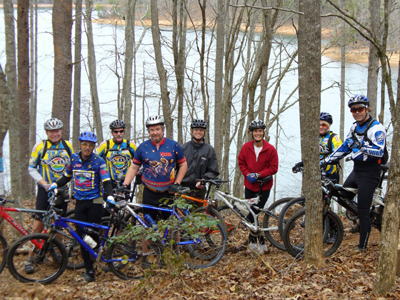
A follow up interview with Mike Riter of Trail Design Specialists!
Mike takes a time out from construction of the Jackrabbit Mountain mountain biking & hiking trail system and answers more of our burning questions…
Editor: A few of the initial goals for this trail project were:
1) Build a trail that appeals to all user skill levels
2) Build a trail that is not only tons of fun but sustainable and low maintenance
3) Cut no corners in regards to the quality of trail constructed
Would you please comment on the progress being made to meet each of these goals?
Mike: 1) I would like to think we are getting closer to that goal all the time. Since we talked last we have completed a few more loops that all appeal to a different style of riding. The Yellow loop is narrower and a lot more twisty that the White and Blue loops. It also adds in some bermed turns and some nice grade dips that just might offer some air opportunities.
The High Point trail is the shortest of the loops so far, but is considered the most challenging. Long steep sustained climbs with some very difficult natural obstacles (can you say rock) lead you to the best view in the whole park, that is if you can clear the “decapitator” first. You can’t escape the loop without negotiating the “pit of despair” essentially a large pit left behind when a tree was toppled in a storm. The only way across is over a 24″ wide ladder bridge which narrows to 18″ in the center.
Burrell Cove adds yet another twist with BMX style humps and tight twisty turns. A stop half way through leads out t o SABA beach, which is a really nice place to soak up the sun. There is also a great rope swing out over the water (when there actually is some in the lake) if you look for it. However I think most will be busy concentrating on the series of tight turns in this area that when viewed from one end resembles a zipper!
2) I think we covered the fun in the previous paragraph, but make no mistake while we live to build deviously fun trail, we are always keeping a close eye on minimizing environmental impact and ensuring every single foot of the trail is properly built so we can enjoy it for generations.
3) A lot of thought goes into what we do. I guess the synopsis of this question is just that. We think and look before we leap. If building a section of trail is just not right we won’t do it, no matter how much fun someone might think it is.
Editor: Besides constructing a quality trail, what other amenities do you think are important to make one trail system stand out from others?
Mike: Everyone has their favorite trail, some of the things that make that trail special are the views, the way the trail flows, and the broad appeal of challenges. People use trails for different reasons, some are out to enjoy what nature has to offer, get exercise, and experience a thrill only nature can provide. Combining all these features into a trail so that the natural beauty of an area is enhanced while making sure the trail still provides a level of challenge(s) appropriate for a particular kind of use and adding in different aspects to appeal to a wider range of users are things I think only a true trail professional can provide. In a lot of ways I see trail building as more of an art form than construction
Editor: How do you rate the work load done by volunteers compared to other projects that you have worked on?
Mike: There are volunteers working on this trail??? Seriously though, the volunteer effort (with the emphasis on EFFORT) on this project has been monumental. I really don’t think this trail system would have happened with out them. I work with volunteers on other projects and while they all work hard, I don’t think any have been at the level of consistent dedication that SABA volunteers have done year after year. What has been special about working with Saba Volunteers? Well they’re all special….ed. You have to be crazy to go what they’ve been through to get this trail done. It motivates me to work just that much harder to provide a trail that is worthy of their efforts. Have there been any difficulties with volunteers?, positives? Well you know how Joanna is…….. No, seriously they have been great to work with. I know from their point of view, more people would make the work go quicker. We keep catching up to them, although we do have a bit of an advantage… We have machinery!
Editor: Based on the design of the trail project and the various skill levels on different trails within Jackrabbit, how do you think this will impact the local economy/area both short term and long term?
Mike: I’d have to say I think the impact in both areas will be favorable. Considering most of the use will come from areas outside of Hayesville/Hiawassee, initially I see it as a day use facility income will be generated through food and fuel purchases. As word spreads people will start coming from farther away and on top of buying food and fuel they will also require overnight accommodations and bike repair/supplies. I really think the Forest Service should take a look at keeping the campground open longer or even year round.
Editor: What is the most interesting thing that happened this year? Has the killer squirrel returned?
Mike: Well let’s see, The squirrel has been strangely absent. Maybe he started a family on the other side of the lake and didn’t feel the need to return. I don’t know, I guess it will remain one of life’s great mysteries. However did I tell you about being stalked by Tarantulas in Texas?? While it didn’t happen at Jack Rabbit, it did happen on a trail. I was on a project out there in the middle of summer and got up at the crack of dawn to try and get everything done before the heat of the day set in. I was about a half mile from the truck when I noticed some small tracks crossing the trail in front of me. Bending down to take a closer look I saw they appeared to have been made quite recently. A rustle to the right caught my attention just as the biggest freakin’ spider I’ve ever seen stepped back onto the trail. I jumped back and just stared at it as it slowly made it’s way into the center of the trail and turned to face me. Great, I needed to continue on down the trail and here I was being challenged by a bug! I thought about kicking it with my boot to move it along, but the fear of being bitten and dying an agonizing death in the desert (Yes, I have a n overactive imagination, and no, I don’t know anything about tarantulas) overruled that and I decided to try and edge past it. Suddenly it took a couple of quick steps towards me and of course I stepped back. That’s when I noticed a small movement in the tall grass to my left. I turned to look, trying not to let the spider out of my sight and saw to my utter horror I was being surrounded by several other tarantulas. This was turning into a carefully choreographed stalkfest and I feared I was the highlight of the menu! As they slowly moved in a flanking maneuver around me I knew I had to act or end up as an appetizer. Summoning all my courage and screaming like a banshee I rushed the ring leader of the pack, leaped over it and sprinted off down the trail. Several times I looked back over my shoulder to see if my would be assassins were following. Fortunately my fear induced scramble had put me out of sight. The rest of the day passed without incident although I did take a different way back to the truck. later after sharing my tale with some locals over a much needed beer, I learned tarantulas could jump as high as 3 feet! Urgh! Masking what remained of my courage with the bottom of the glass, I decided it was high time to head home. Yep, wonder what’s waitin’ for me there…….
Editor: What type of machines are you using to construct the trail and are there any specific reasons you chose them?
Mike: I use machines exclusively from Ditch Witch. The SK-500 and SK-650 are rubber tracked mini skid steer machines with a light foot print and a lot of power. Imagine a bulldozer the size of a riding lawnmower that you walk behind and you have a rough idea of what these look like. The advantages are that we can move a lot of dirt pretty fast, utilize a variety of attachments and build cool trail features that would be very time consuming to do by hand.
Editor: How does weather affect trail construction and what type of impact is most detrimental to the well being of a trail?
Mike: We can work through most minor weather conditions, however heavy rains, snow and frozen ground present mud issues that end up causing us to make more of a mess that progress. Fortunately the speed at which the machines can build trail allows us to make up time lost to inclement weather. The hardest thing to over come on a trail is freeze/thaw conditions. The well being of a trail is solely dependent on how well compacted the surface is. When the ground freezes and then thaws the top inch or so of the trail is heaved upward causing a loss of compaction. If the trail is used immediately after this type of event, then the soft soil will be displaced by the user causing water to pool or run down the trail the next time it rains.
Editor: …and finally, have you changed your thoughts on your super power? last year you wanted to be able to fly. I see that has not happened, but what are you hoping for in 2008?
Mike: Wait, who says I can’t fly!?? Darn, I guess it was just a dream. My goal for 2008 is to become “trail finisher man”. With powers like that I could continue to work towards my goal of total world domination through trails, (insert evil laugh here).
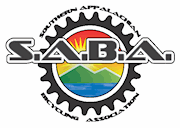






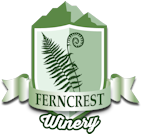


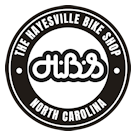
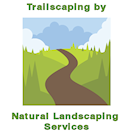





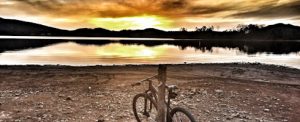
You must be logged in to post a comment.